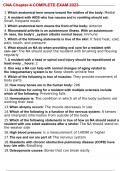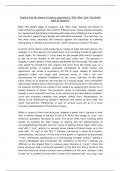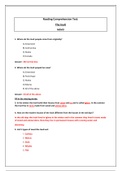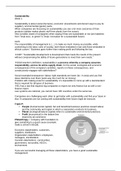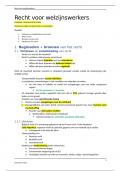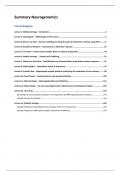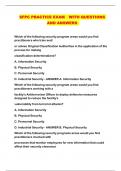“Monopolies result in a misallocation of resources compared with competition and should therefore
be broken up”. Explain and critically examine this reasoning. (20)
A monopoly is a market structure whereby one firm supplies all the output in the market
without facing competition due to high barriers to entry.
Given that monopolies are
not allocatively efficient,
this results in misallocation of
resources compared with
perfect competition and
DWL
should therefore be broken
up. Allocative efficiency occurs
when there is an optimal
distribution of goods and
services in the market,
according to consumer
preferences. At the profit
maximising level of output,
MR = MC, allocative efficiency
occurs where AR = MC. In the
diagram above, at the profit
maximising level, the monopoly is allocatively inefficient as AR > MC. As a result of this, consumers
are forced to pay higher prices than what the marginal cost of production is.
This leads to a fall in consumer surplus. This then leaves a consumer deadweight welfare loss,
depicted by DWL on the diagram, which represents the misallocation of resources as no one
benefits from the fall in consumer surplus. Monopolies limits output which then restricts choice for
consumers, as they have less options. Therefore, resources are not following consumer demand
compared to perfect competition, in which firms are allocatively efficient. Hence, monopolies should
be broken up in order to stimulate more competition. Increased competition will result in firms
becoming price takers, which then may cause firms to become allocatively efficient as price falls and
P = MC. However, breaking up monopolies may not lead to resources being allocated efficiently. For
example, breaking up a natural monopoly will not be efficient. Natural monopolies occur when only
one firm in an industry can exploit the resources available most efficiently. Breaking up a natural
monopoly will result in in increased competition. This then causes each individual firm to incur
higher average costs, as economies of scale are only attained at extremely large quantities of
output. Therefore, resulting in an inefficient use of resources, which in turn would lead to higher
prices for consumers. Due to this, utility companies, such as gas and electricity firms, are usually
natural monopolies.
As well as not being allocatively efficient, monopolies are not productively efficient either.
Productive efficiency occurs when the production of goods and services is maximised at the
lowest possible average cost. It happens during the complete exploitation of economies of
scale. Perfectly competitive firms are able to attain productive efficiency as firms seek to
minimise costs and continue production at the lowest point of the average cost curve. In the
diagram above, at the profit maximising level out output, MR = MC, a firm with monopoly
power does not operate at the lowest point of the average cost curve. This is due to
be broken up”. Explain and critically examine this reasoning. (20)
A monopoly is a market structure whereby one firm supplies all the output in the market
without facing competition due to high barriers to entry.
Given that monopolies are
not allocatively efficient,
this results in misallocation of
resources compared with
perfect competition and
DWL
should therefore be broken
up. Allocative efficiency occurs
when there is an optimal
distribution of goods and
services in the market,
according to consumer
preferences. At the profit
maximising level of output,
MR = MC, allocative efficiency
occurs where AR = MC. In the
diagram above, at the profit
maximising level, the monopoly is allocatively inefficient as AR > MC. As a result of this, consumers
are forced to pay higher prices than what the marginal cost of production is.
This leads to a fall in consumer surplus. This then leaves a consumer deadweight welfare loss,
depicted by DWL on the diagram, which represents the misallocation of resources as no one
benefits from the fall in consumer surplus. Monopolies limits output which then restricts choice for
consumers, as they have less options. Therefore, resources are not following consumer demand
compared to perfect competition, in which firms are allocatively efficient. Hence, monopolies should
be broken up in order to stimulate more competition. Increased competition will result in firms
becoming price takers, which then may cause firms to become allocatively efficient as price falls and
P = MC. However, breaking up monopolies may not lead to resources being allocated efficiently. For
example, breaking up a natural monopoly will not be efficient. Natural monopolies occur when only
one firm in an industry can exploit the resources available most efficiently. Breaking up a natural
monopoly will result in in increased competition. This then causes each individual firm to incur
higher average costs, as economies of scale are only attained at extremely large quantities of
output. Therefore, resulting in an inefficient use of resources, which in turn would lead to higher
prices for consumers. Due to this, utility companies, such as gas and electricity firms, are usually
natural monopolies.
As well as not being allocatively efficient, monopolies are not productively efficient either.
Productive efficiency occurs when the production of goods and services is maximised at the
lowest possible average cost. It happens during the complete exploitation of economies of
scale. Perfectly competitive firms are able to attain productive efficiency as firms seek to
minimise costs and continue production at the lowest point of the average cost curve. In the
diagram above, at the profit maximising level out output, MR = MC, a firm with monopoly
power does not operate at the lowest point of the average cost curve. This is due to


